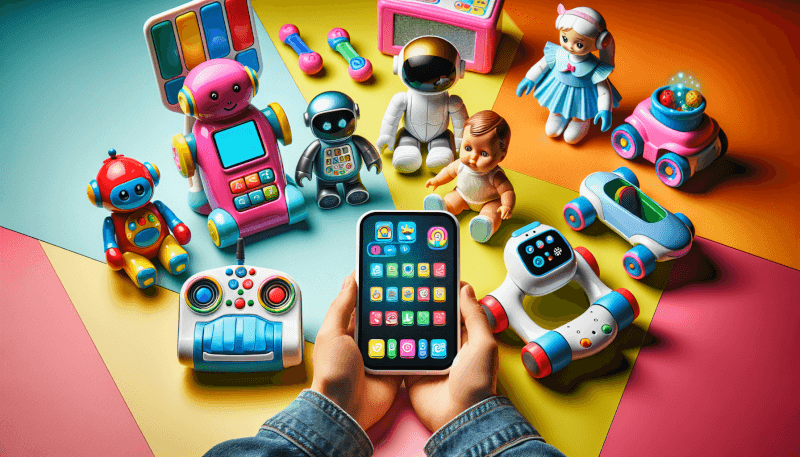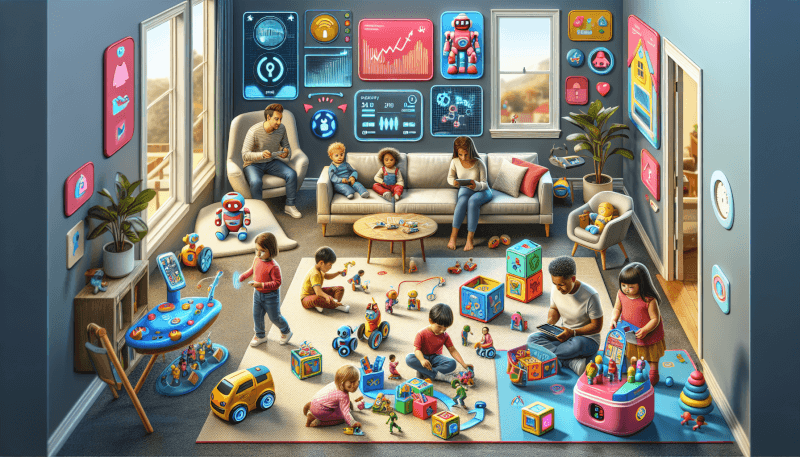Are you a parent who is concerned about your child’s safety when playing with smart toys? It’s important to know if these toys have parental control options to ensure that you can monitor and control your child’s interactions. In this article, we will explore the topic of whether or not smart toys come with parental control options, providing you with the information you need to make an informed decision for your family’s peace of mind.

Key Features of Smart Toys
Interactive capabilities
Smart toys are designed to engage and interact with children, providing a dynamic and immersive play experience. These toys often have features like sound effects, motion sensors, and lights that respond to a child’s actions. By incorporating interactive capabilities, smart toys are able to captivate children’s attention and foster cognitive and social development.
Connectivity to other devices
One of the key features of smart toys is their ability to connect to other devices such as smartphones, tablets, or computers. This connectivity allows parents and children to access additional content, updates, or features. It also enables seamless integration with online platforms, providing a more comprehensive and immersive play experience.
Data collection and storage
Smart toys often collect and store data about children’s interactions, preferences, and usage patterns. This data can be used to personalize the toy’s responses and provide tailored experiences. However, the collection and storage of personal data raise concerns about privacy and data protection. Parental control options play a crucial role in managing and regulating the data collected by smart toys.
Educational aspects
Many smart toys are designed with educational objectives in mind. They can teach children important skills such as problem-solving, critical thinking, and coding. These toys often incorporate educational content, interactive lessons, and quizzes. Parental control options can help parents customize and manage the educational content to ensure it aligns with their child’s age, interests, and learning needs.
Importance of Parental Control
Ensuring children’s safety
Parental control features are essential for keeping children safe while using smart toys. They allow parents to regulate access to certain features or content that may be inappropriate or potentially harmful to young users. By setting up appropriate restrictions, parents can create a safe and secure play environment for their children.
Monitoring and restricting content
With the increasing connectivity of smart toys, children can easily access online content, including videos, games, and websites. Parental control options provide parents with the ability to monitor and control the content that their children can access. This ensures that children are exposed to age-appropriate and safe content while using smart toys.
Managing privacy and data protection
Smart toys often collect personal data about children, such as their names, ages, and preferences. Parental control options play a crucial role in managing and protecting this sensitive information. They allow parents to control data sharing settings and decide what information is collected and stored by the toy. This helps parents maintain their child’s privacy and reduces the risk of data breaches or misuse.

Types of Parental Control Options
Content filtering and blocking
Content filtering and blocking features enable parents to restrict access to certain types of content, such as violent or explicit material. By defining filters and blocking certain websites or apps, parents can ensure that their children are exposed only to appropriate and safe content while using smart toys.
Time restrictions and usage limits
Time restrictions and usage limits allow parents to set specific timeframes during which children can use smart toys. This feature helps parents control and regulate screen time, ensuring that children have a healthy balance between playtime and other activities. Setting usage limits can also prevent excessive exposure to screens, which can have negative effects on children’s physical and mental well-being.
Privacy settings and data management
Parental control options include privacy settings and data management features that allow parents to control how their child’s personal information is collected, used, and shared. These settings enable parents to customize the privacy levels and manage data permissions for smart toy applications, ensuring that their child’s personal information is protected.
Remote access and monitoring
Some parental control options provide remote access and monitoring capabilities. This allows parents to monitor their child’s activities while using the smart toys, even when they are not physically present. Remote access features enable parents to check the content their child is accessing, adjust settings, and ensure that their child is safe and engaged in appropriate activities.
Built-in Parental Control Features
Password protection
Many smart toys come with built-in password protection features. Parents can set up passwords or PIN codes to restrict access to certain features or content. This helps prevent unauthorized access and ensures that parents have control over their child’s play experience.
Age-appropriate content filtering
Built-in parental control features often include age-appropriate content filtering options. These features automatically filter and block content that may not be suitable for a specific age group. By default, smart toys with age-appropriate content filtering help parents ensure that their child is exposed only to content that is suitable for their developmental stage.
Internet access restrictions
Smart toys with built-in parental control features often provide options for controlling internet access. Parents can define websites or online platforms that are safe and suitable for their child to access, while blocking others. This helps create a controlled online environment that protects children from inappropriate or harmful content.
Parental app management
Built-in parental control features also allow parents to manage and control the applications that are installed on the smart toy. Parents can choose which apps are accessible to their child, ensuring that they only have access to applications that are safe, educational, and appropriate for their age.

Third-party Parental Control Solutions
Introduction to third-party apps
In addition to the built-in parental control features offered by smart toy manufacturers, there are also third-party apps available that provide enhanced parental control options. These apps can offer additional functionalities and customization options, allowing parents to further tailor their child’s play experience and ensure their safety.
Compatibility with smart toys
Third-party parental control apps are designed to work with a wide range of smart toys. They are often compatible with multiple brands and models, making them a versatile option for parents who have different types of smart toys in their household. These apps can be installed on smartphones or tablets, providing a convenient way for parents to manage and control multiple smart toys from a single device.
Features and functionalities
Third-party parental control apps offer a variety of features and functionalities. They typically include content filtering, time restrictions, privacy settings, and remote monitoring capabilities. Some apps also provide advanced features like geolocation tracking, real-time notifications, and detailed activity logs. These features give parents more control and insight into their child’s play and online activities.
Pros and cons
The use of third-party parental control apps has both advantages and disadvantages. On the positive side, these apps often offer more extensive control options than built-in features, allowing parents to customize and tailor the settings to their specific requirements. They also provide a centralized platform for managing multiple smart toys. However, some third-party apps may come with a cost or require additional setup steps, which may be a drawback for some parents.
Popular Smart Toy Brands and Parental Control Options
Brand A
Brand A is well-known for its range of smart toys that incorporate educational and interactive features. Their smart toys come with built-in parental control options, including content filtering and age-appropriate settings. The parental app management feature allows parents to easily manage and customize the applications on the toy. Brand A also offers compatibility with certain third-party parental control apps, providing even more control options for parents.
Brand B
Brand B focuses on creating smart toys that promote imaginative play and creativity. Their toys are designed to stimulate children’s creativity and problem-solving skills. Brand B’s smart toys have built-in parental control features, such as age-appropriate content filtering and time restrictions. Parents can also monitor their child’s activities remotely through their dedicated parental control app.
Brand C
Brand C offers a range of smart toys that combine entertainment and education. Their toys feature interactive capabilities and educational content. Brand C’s parental control options include age-appropriate content filtering and password protection. Parents can also set time restrictions and manage their child’s app access through their dedicated app.
Brand D
Brand D is known for its smart toys that focus on physical activity and outdoor play. Their toys encourage children to stay active and engage in outdoor adventures. Brand D’s parental control options include content filtering and internet access restrictions. Parents can also set usage limits to balance screen time with physical playtime.

Considerations for Choosing Smart Toys with Parental Control
Age appropriateness
When choosing smart toys with parental control options, it is important to consider the age appropriateness of the toys. Ensure that the content, features, and functionalities align with your child’s developmental stage and interests. Look for toys that offer age-appropriate content filtering and customization options to ensure a safe and educational play experience.
Ease of setup and use
Consider the ease of setup and use when choosing smart toys with parental control options. Look for toys that have intuitive interfaces and clear instructions for setting up parental controls. User-friendly parental control apps or interfaces can make it easier for parents to manage and customize the toy’s settings without any hassle.
Comprehensive control features
Evaluate the comprehensiveness of the parental control options offered by the smart toy. Consider the range of control features available, including content filtering, time restrictions, privacy settings, and remote monitoring. Look for toys that provide a wide range of customization options, allowing you to tailor the settings according to your child’s needs and your preferences as a parent.
Reviews and recommendations
Read reviews and recommendations from other parents or experts to get insights into the effectiveness and reliability of the parental control options offered by different smart toy brands. Consider the experiences of other parents and their feedback on the ease of use, reliability, and overall satisfaction with the parental control features. This can help you make an informed decision and choose a smart toy that meets your specific requirements.
Balancing Safety and Fun
Encouraging creativity and exploration
While ensuring safety is important, it is equally important to encourage children’s creativity and exploration while using smart toys. Parental control options should strike a balance between providing a safe play environment and allowing children to explore and express their imagination. Find smart toys that offer a mix of educational and open-ended play options, giving children the freedom to learn and have fun.
Striking a balance between restrictions and freedom
Balance is key when it comes to parental control. It’s important to set appropriate restrictions and guidelines, but also allow children to have some degree of freedom and autonomy. Find smart toys that offer customizable control options, allowing you to gradually adjust the settings as your child grows and matures. This way, you can ensure their safety while also fostering their independence and decision-making skills.
Educating children about online safety
Parental control features should not be a substitute for educating children about online safety. It is crucial to have open and honest conversations with your child about the potential risks and dangers associated with internet use. Teach them about privacy, appropriate online behavior, and how to recognize and respond to potential threats. By educating children about online safety, you empower them to make responsible choices and stay safe while using smart toys or any other digital devices.

Regulations and Standards for Smart Toy Safety
Overview of regulatory bodies
Various regulatory bodies around the world are responsible for setting standards and regulations for smart toy safety. These bodies include organizations like the Consumer Product Safety Commission (CPSC) in the United States, the European Union’s Toy Safety Directive, and the International Organization for Standardization (ISO). These organizations work to establish guidelines and requirements that ensure smart toys are safe for children to use.
Safety and privacy standards
Regulations and standards for smart toys cover various aspects, including safety and privacy. Safety standards focus on factors such as material safety, durability, and mechanical safety to prevent accidents and injuries. Privacy standards address concerns related to data collection and protection, ensuring that smart toys comply with privacy regulations and safeguard children’s personal information.
Compliance and certification
Smart toy manufacturers are required to comply with the regulatory standards and guidelines established by the respective regulatory bodies. Compliance involves conducting safety tests, adhering to quality control processes, and meeting specific requirements. To demonstrate compliance, smart toy manufacturers may obtain certifications or marks indicating that their products meet the necessary safety and privacy standards.
Conclusion
Smart toys offer exciting and interactive experiences for children, but with these innovations come the need for parental control options to ensure children’s safety, manage content, protect privacy, and monitor their online activities. Built-in parental control features and third-party apps provide various options for parents to customize the play experience, making smart toys a valuable tool for both entertainment and education. By considering factors such as age appropriateness, ease of use, and comprehensive control features, parents can choose smart toys with effective parental control options that strike a balance between safety and fun. Additionally, educating children about online safety and being aware of regulations and standards for smart toy safety can further enhance the benefits of using smart toys with parental control options. With the right combination of parental control and responsible use, smart toys can provide an enriching and safe play experience for children in the digital age.


